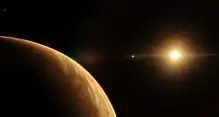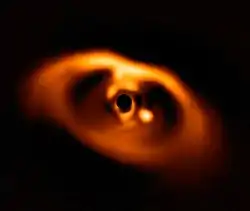Kepler-186e
Kepler-186e (also known by its Kepler Object of Interest designation KOI-571.04) is a confirmed exoplanet orbiting the red dwarf star Kepler-186, approximately 582 light years away from Earth in the constellation of Cygnus. It is near the optimistic habitable zone but probably not in it, possibly making it have a runaway greenhouse effect, like Venus. The exoplanet was found by using the transit method, in which the dimming effect that a planet causes as it crosses in front of its star is measured. Four additional planets orbiting the star (all modestly larger than Earth) were also discovered.
 Artistic simulation of Kepler-186e, depicted as a hot desert planet, orbiting its host star. | |
| Discovery | |
|---|---|
| Discovery site | Kepler Space Observatory |
| Discovery date | 17 April 2014 |
| Transit | |
| Orbital characteristics | |
| 0.11–0.1216 AU | |
| Eccentricity | <0.24 |
| 22.407704 d | |
| Inclination | 88.24 |
| Star | Kepler-186 |
| Physical characteristics | |
Mean radius | 1.27±0.15 R⊕ |
| Mass | ~2.29 M⊕ |
| Temperature | 323 K (50 °C; 122 °F) |
Characteristics
Mass, orbit, and composition
The exoplanet is only slightly larger than Earth, with a radius 1.27–1.33 times that of Earth. Its mass is not known but it is likely to have a similar composition to Earth, giving it a mass of about 2.29–2.72 times the mass of the Earth. Kepler-186e orbits an M-dwarf star with about 4% of the Sun's luminosity with an orbital period of 22.4077 days and an orbital radius of about 0.11 times that of Earth's (compared to 0.39 AU for Mercury). The habitable zone for this system is estimated conservatively to extend over distances receiving from 88% to 25% of Earth's illumination (from 0.22 to 0.40 AU).[1]
Formation, tidal evolution and habitability
The star hosts four other planets discovered so far. Because of the very slow evolution of red dwarfs, the age of the Kepler-186 system is poorly constrained, although it is likely to be greater than a few billion years.[3] Due to its proximity to its star, Kepler-186e is probably tidally locked, facing one side to its star at all times, and one side facing away from its star at all times. The side in permanent daylight would be extremely hot and the side in permanent darkness would be extremely cold. But between these hostile environments, there would be a sliver of habitability, which could support life.
Kepler-186e's axial tilt (obliquity) is likely very small, in which case it would not have tilt-induced seasons as Earth and Mars do. Its orbit is probably close to circular, so it will also lack eccentricity-induced seasonal changes like those of Mars. However, the axial tilt could be larger (about 23 degrees) if another undetected nontransiting planet orbits between it and Kepler-186f; planetary formation simulations have shown that the presence of at least one additional planet in this region is likely. If such a planet exists, it cannot be much more massive than Earth as it would then cause orbital instabilities.[3]
Discovery
The exoplanet, along with the other planets of the Kepler-186 system (including 186f), were announced on April 17, 2014 in an article published by NASA.[2]
Previous names
As the Kepler telescope observational campaign proceeded, an initially identified system was entered in the Kepler Input Catalog (KIC), and then progressed as a candidate host of planets to a Kepler Object of Interest (KOI). Thus, Kepler 186 started as KIC 8120608 and then was identified as KOI 571.[4] Kepler 186e was mentioned when known as KOI-571-04 or KOI-571.04 or using similar nomenclatures in 2013 in various discussions and publications before its full confirmation.[5]
References
- Quintana, E. V.; Barclay, T.; Raymond, S. N.; Rowe, J. F.; Bolmont, E.; Caldwell, D. A.; Howell, S. B.; Kane, S. R.; Huber, D.; Crepp, J. R.; Lissauer, J. J.; Ciardi, D. R.; Coughlin, J. L.; Everett, M. E.; Henze, C. E.; Horch, E.; Isaacson, H.; Ford, E. B.; Adams, F. C.; Still, M.; Hunter, R. C.; Quarles, B.; Selsis, F. (18 April 2014). "An Earth-Sized Planet in the Habitable Zone of a Cool Star" (PDF). Science. 344 (6181): 277–280. arXiv:1404.5667. Bibcode:2014Sci...344..277Q. doi:10.1126/science.1249403. PMID 24744370.
- Johnson, Michele; Harrington, J.D. (17 April 2014). "NASA's Kepler Discovers First Earth-Size Planet In The 'Habitable Zone' of Another Star". NASA. Archived from the original on 17 April 2014.
- Bolmont, Emeline; Raymond, Sean N.; von Paris, Philip; Selsis, Franck; Hersant, Franck; Quintana, Elisa V.; Barclay, Thomas (16 April 2014). "Formation, tidal evolution and habitability of the Kepler-186 system". The Astrophysical Journal. 1404: 4368. arXiv:1404.4368. Bibcode:2014ApJ...793....3B. doi:10.1088/0004-637X/793/1/3.
- Rowe, Jason F.; Marcy, Geoffrey W.; Lissauer, Jack J.; Jontof-Hutter, Daniel; Mullally, Fergal; Gilliland, Ronald L.; Issacson, Howard; Ford, Eric; Howell, Steve B.; Borucki, William J.; Haas, Michael; Huber, Daniel; Steffen, Jason H.; Thompson, Susan E.; Quintana, Elisa; Barclay, Thomas; Still, Martin; Fortney, Jonathan; Gautier, T. N.; Hunter, Roger; Caldwell, Douglas A.; Ciardi, David R.; Devore, Edna; Cochran, William; Jenkins, Jon; Agol, Eric; Carter, Joshua A.; Geary, John (27 February 2014). "Validation of Kepler's Multiple Planet Candidates. III: Light Curve Analysis & Announcement of Hundreds of New Multi-planet Systems". The Astrophysical Journal. 784: 45. arXiv:1402.6534. Bibcode:2014ApJ...784...45R. doi:10.1088/0004-637X/784/1/45.
- Glister, Paul (5 November 2013). "Earth-Sized Planets in Habitable Zone Common". Centauri Dreams. Archived from the original on 19 April 2014. See comment by "Holger 16 November 2013 at 14:21".
^ redakce ["editor"] (6 August 2013). "Kepler (asi) našel obyvatelnou planetu o velikosti Země" [Kepler (probably) found a habitable planet the size of Earth] (in Czech). exoplanety.cz. Archived from the original on 20 August 2013.
^ "Kepler: Erster Kandidat einer habitablen Exoerde Veröffentlicht" [Kepler: First candidate of a habitable Exoplanet Published]. Zauber der Sterne [Magic of the stars] (in German). 19 August 2013. Archived from the original on 27 September 2013.
^ Bovaird, Timothy; Lineweaver, Charles H. (1 August 2013). "Exoplanet Predictions Based on the Generalised Titius-Bode Relation". Monthly Notices of the Royal Astronomical Society. 435 (2): 14–15. arXiv:1304.3341. Bibcode:2013MNRAS.435.1126B. doi:10.1093/mnras/stt1357.

